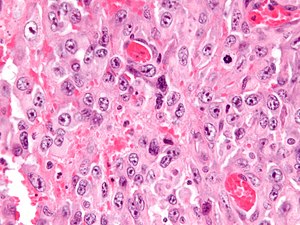Difference between revisions of "Nucleolus"
Jump to navigation
Jump to search
| Line 10: | Line 10: | ||
*Reed-Sternberg cell ([[Hodgkin lymphoma]]) ~ 5-7 micrometers.<ref name=Ref_PCPBoD8_329>{{Ref PCPBoD8|329}}</ref> | *Reed-Sternberg cell ([[Hodgkin lymphoma]]) ~ 5-7 micrometers.<ref name=Ref_PCPBoD8_329>{{Ref PCPBoD8|329}}</ref> | ||
Image | ===Image=== | ||
<gallery> | |||
Image:Glioblastoma_with_extreme_nuclear_enlargement_-_very_high_mag.jpg | Extreme nuclear enlargement with huge macronucleoli. (WC) | |||
</gallery> | |||
==Red nucleolus== | ==Red nucleolus== | ||
Revision as of 05:47, 21 October 2015
The nucleolus (plural nucleoli) is a thingy in the nucleus that may give the pathologist a clue to what they are looking at.
Generally speaking, large nucleoli suggest something is happening - they are associated with gene transcription. Large nucleoli are seen in malignancies and reactive conditions.
Macronucleolus
Almost the size of RBC ~ 6-7 micrometers.
Example:
- Reed-Sternberg cell (Hodgkin lymphoma) ~ 5-7 micrometers.[1]
Image
Red nucleolus
Large - can be seen with 10x objective.
Examples:
- Melanoma.
- Serous carcinoma.
- Hereditary leiomyomatosis renal cell carcinoma syndrome associated renal cell carcinoma.
Large nucleolus
Large - can be seen with 10x objective.
Examples:
- Melanoma.
- Carcinoma.
- Serous carcinoma.
- Adenocarcinoma.
- High-grade renal cell carcinoma.
- Sarcoma:
- Ganglion cell:
- Ganglion (benign).
- Gangliocytic paraganglioma.
- Ganglioneuroma.
Medium-sized nucleolus
Medium - can be seen well with 20x objective.
Examples:
- Prostatic adenocarcinoma.
- Oncocytoma.
- Mammary carcinoma, no special type.
- Embryonal carcinoma.
- Squamous metaplasia of the uterine cervix.
Small
Small - hard to see at 20x objective, seen with 40x objective.
Examples:
Indistinct nucleolus
Not present - cannot see with 40x objective.
Examples:
- Small cell carcinoma.
- Neuroendocrine carcinoma.
See also
References
- ↑ Mitchell, Richard; Kumar, Vinay; Fausto, Nelson; Abbas, Abul K.; Aster, Jon (2011). Pocket Companion to Robbins & Cotran Pathologic Basis of Disease (8th ed.). Elsevier Saunders. pp. 329. ISBN 978-1416054542.

